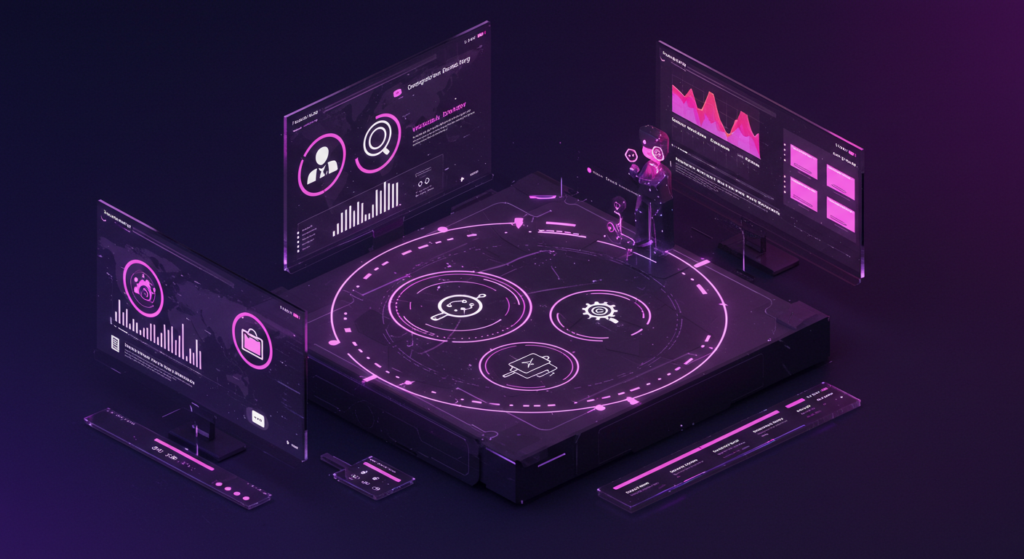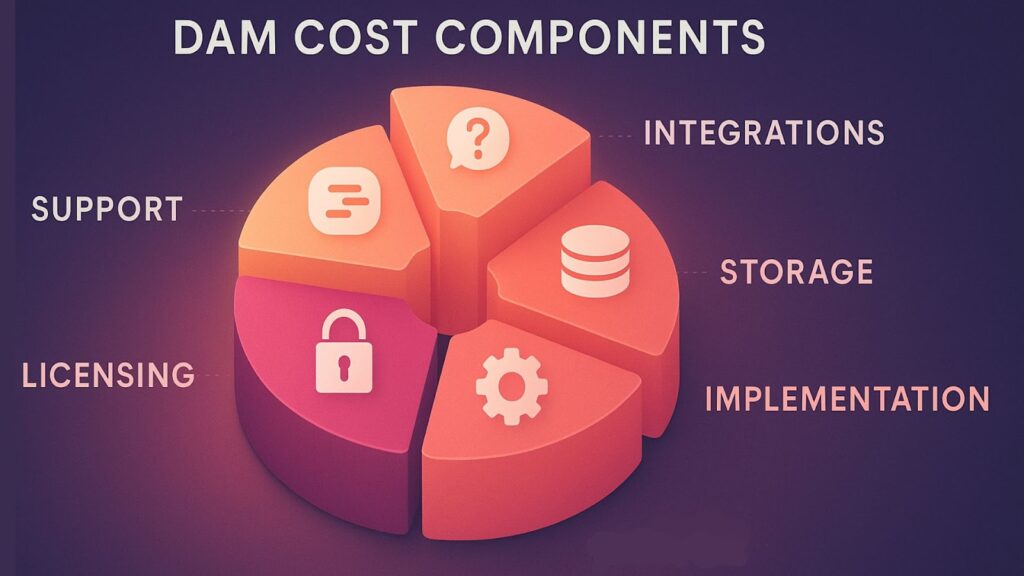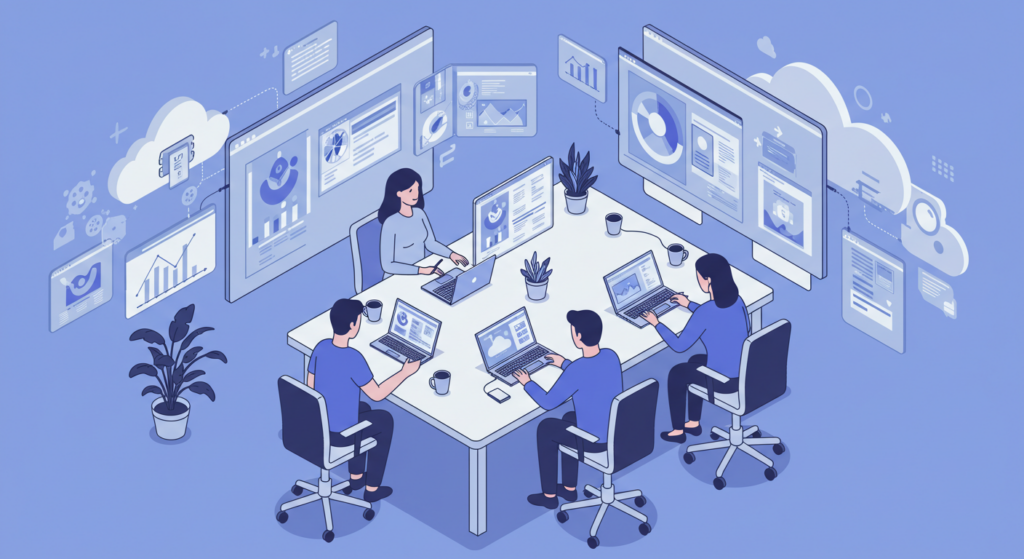Enterprise digital asset management selection requires evaluating core criteria: scalability, security, integration capabilities, and AI-powered features.
- Most enterprise DAM systems vary widely in annual pricing, with hidden costs to watch for.
- 74% of enterprises struggle to achieve scaled value from technology implementations without proper planning.
- Cloud-based solutions typically offer faster deployment and lower infrastructure costs than on-premise alternatives.
- Integration ecosystem compatibility determines long-term success for most implementations.
Start with a comprehensive needs assessment and prioritize solutions that offer transparent pricing with enterprise-grade security.
Selecting the right digital asset management system for your enterprise isn’t just about finding software that stores files. With the global enterprise content management market projected to reach $150.97 billion by 2032, organizations are recognizing that strategic DAM selection can transform their entire content operations.
However, 74% of companies struggle to achieve and scale value from their technology implementations, primarily due to inadequate planning and requirements gathering. Enterprise marketing teams face unique challenges that demand platforms that can handle massive scale, complex workflows, and strict compliance requirements.
This comprehensive guide will walk you through everything you need to evaluate when choosing a digital asset management system that can truly scale with your enterprise marketing operations.
What Makes Enterprise Digital Asset Management System Selection Different from Standard Solutions?
Enterprise DAM requirements differ dramatically from small business needs. Where a startup might need to manage thousands of assets for dozens of users, enterprise organizations typically handle significantly larger volumes across hundreds of users spanning multiple departments, regions, and external partners.
Enterprise teams must navigate multi-brand management, strict compliance frameworks, and integration with dozens of existing systems. Enterprise content management trends show that highly regulated industries like BFSI and healthcare are driving significant adoption, with organizations increasingly seeking solutions that provide secure document storage, audit trails, and compliance monitoring capabilities.
Enterprise marketing teams also deal with sophisticated approval workflows involving legal, brand, and regulatory review processes that can span weeks. These requirements demand DAM software with advanced workflow automation, granular permission controls, and detailed audit capabilities that basic solutions can’t provide.
Why Most DAM Implementations Fail in Enterprise Environments
Implementation failures rarely stem from technology limitations. Instead, they typically result from misaligned expectations, inadequate change management, and insufficient requirements gathering. Organizations often underestimate the complexity of migrating existing assets, training diverse user groups, and integrating with complex technology ecosystems.
The most successful implementations begin with extensive stakeholder interviews across all affected departments. Marketing, creative, legal, IT, and compliance teams each have distinct needs that must be addressed from day one. Enterprise SMART DAM platforms excel when they can accommodate these diverse requirements without compromising functionality.
Enterprise vs. Small Business DAM Requirements
Enterprise SMART DAM systems must support advanced metadata schemas, automated content lifecycle management, and sophisticated analytics that small business solutions rarely offer. While a small business might use simple folder structures, enterprises require dynamic taxonomies that can evolve with organizational changes and simultaneously support multiple content classification systems.

How Do You Assess Your Organization’s DAM Requirements?
Effective requirements gathering starts with understanding your current digital asset ecosystem. Begin by conducting a comprehensive content audit to identify all existing repositories, file types, storage volumes, and user access patterns. Most enterprise organizations discover they have content scattered across numerous different systems, creating significant efficiency losses.
Document your user personas carefully. A global pharmaceutical company might have research scientists who need access to technical documentation, marketing teams creating campaign materials, and regulatory affairs specialists managing compliance documents. Each group has distinct workflow requirements, security clearance levels, and integration needs.
Consider your growth projections realistically. The digital asset management market is growing at 17% annually, suggesting most organizations will see substantial increases in content volume over the next five years. Determining whether you need a DAM system in the first place requires honest assessment of your current pain points and future requirements.
What Questions Should You Ask During Requirements Gathering?
Focus your stakeholder interviews on specific use cases rather than abstract feature lists. Ask questions like: “Walk me through the exact steps you take to create, review, and publish a marketing campaign.” Document every system touched, approval required, and potential bottleneck encountered.
Understand compliance requirements thoroughly. Healthcare organizations must consider HIPAA implications, financial services need to address SEC regulations, and global companies must navigate GDPR and other international data protection laws.
How to Calculate Your Total Storage and User Needs
Storage requirements extend beyond current files. Factor in version control, derivative assets, and archived content that must remain accessible for compliance purposes. Many organizations greatly underestimate storage requirements when they fail to account for these factors.
User licensing models vary across DAM software vendors. Some charge per active user, others use concurrent users, and a few offer unlimited user tiers. Calculate costs based on your actual usage patterns rather than theoretical user counts.
What Are the Must-Have Features for Enterprise Marketing Teams?

Modern enterprise DAM software must deliver far more than basic storage and organization. Here are the essential capabilities that separate enterprise-grade solutions from simpler alternatives:
1. AI-Powered Search and Automated Metadata
Advanced search capabilities can dramatically improve asset discovery time compared to traditional keyword-based systems. Look for solutions that offer visual similarity search, automatic content recognition, and natural language query processing.
2. Advanced Workflow Automation and Approval Processes
Enterprise marketing campaigns often require approval from legal, brand, regulatory, and senior management teams. The best DAM systems automate routing, send intelligent notifications, and provide clear audit trails for compliance reporting.
3. Brand Compliance and Governance Controls
Automated brand compliance checking can prevent costly mistakes before they reach market. Advanced systems use AI to detect potential brand guideline violations, flag outdated assets, and ensure consistent application of visual identity standards.
4. Dynamic Asset Transformation and Delivery
Modern marketing requires assets optimized for dozens of channels and formats. Enterprise DAM software should automatically generate responsive variants, apply channel-specific optimizations, and deliver content through high-performance content delivery networks.
5. Real-Time Analytics and Performance Tracking
Understanding which assets drive engagement and conversions enables data-driven content strategy decisions. Look for platforms that provide detailed usage analytics, performance metrics, and integration with marketing analytics platforms.
6. Headless/API-First Architecture
Enterprise technology ecosystems require seamless integration capabilities. API-first platforms enable custom integrations, support headless content delivery, and adapt to evolving technology requirements without major platform changes.
7. Enterprise-Grade Security and Permissions
Security requirements include encryption at rest and in transit, detailed access controls, single sign-on integration, and compliance with frameworks like SOC 2, ISO 27001, and FedRAMP for government organizations.
8. Global Content Distribution Capabilities
Multinational organizations need DAM systems that support multiple languages, regional compliance requirements, and localized content delivery through global content distribution networks.
Which Integration Capabilities Are Non-Negotiable?
The average enterprise uses numerous content-related systems that must seamlessly work together. Priority integrations typically include creative tools (Adobe Creative Suite), marketing automation platforms, content management systems, and analytics platforms. Evaluate current integration needs and potential future requirements as your technology stack evolves.
How Important Are AI and Automation Features?
AI capabilities are transforming enterprise content operations, but implementation success varies widely. Focus on AI features that solve specific business problems rather than pursuing technology for its own sake. Automated metadata generation, intelligent content recommendations, and automated compliance checking typically deliver the highest ROI.
How Do DAM Pricing Models Work for Enterprise Organizations?
Enterprise DAM system pricing varies based on features, user counts, storage requirements, and deployment models. Enterprise solutions often require significant annual investments, with complex implementations including professional services, integration costs, and ongoing support. Understanding how much a digital asset management system costs helps organizations budget appropriately for their selection process.
Subscription-based models dominate the enterprise market, offering predictable costs and regular feature updates. However, some organizations prefer perpetual licensing for budget predictability or compliance requirements. Cloud-based solutions typically offer lower total cost of ownership than on-premise deployments when factoring in infrastructure, maintenance, and support costs.
Storage pricing often represents the largest variable cost component. Some vendors charge per gigabyte consumed, others offer fixed storage tiers, and a few provide unlimited storage as part of premium packages. Calculate total costs based on realistic growth projections rather than current requirements.

What Should You Budget for DAM Implementation?
Beyond software licensing, budget for data migration, user training, and integration development for complex ecosystems. Professional services costs vary but represent a significant portion of total implementation expenses for large enterprise deployments.
How to Avoid Common Pricing Pitfalls
Watch for hidden costs in user licensing models, overage charges for storage or bandwidth usage, and expensive add-on modules for essential features. Some vendors offer attractive introductory pricing that increases significantly after the first year. Always request detailed pricing for years two and three to understand total cost implications.
What Does the Enterprise DAM Vendor Selection Process Look Like?
Successful vendor selection requires structured evaluation processes that involve stakeholders across the organization. Begin by assembling a cross-functional selection team that includes representatives from marketing, creative, IT, legal, and senior management. Each group brings essential perspectives that influence long-term success.
Create detailed vendor briefing documents that clearly articulate your requirements, use cases, and evaluation criteria. This documentation ensures consistent vendor presentations and enables meaningful comparisons between solutions.
Structure vendor demonstrations around specific use cases rather than generic feature tours. Ask vendors to demonstrate how their platform would handle your actual workflows, content types, and integration requirements. The best vendors will customize demonstrations based on your briefing documents.
How Long Does Enterprise DAM Selection Typically Take?
Enterprise DAM selection requires adequate time for thorough evaluation. This timeline includes stakeholder interviews, vendor research and briefing, demonstrations and proof of concepts, reference checks and final evaluation, and contract negotiation.
Rushing the selection process often leads to poor vendor fit and expensive changes later. Organizations that invest adequate time in requirements gathering and evaluation typically achieve faster implementations and higher user adoption rates.
What Red Flags Should You Watch for During Vendor Evaluations?
Be cautious of vendors who can’t provide detailed technical architecture information, refuse to connect you with existing customers in similar industries, or pressure you to make quick decisions. Quality vendors understand that enterprise selection requires careful evaluation and will support thorough due diligence processes.
Watch for solutions that require extensive customization to meet basic requirements. While some customization is normal for enterprise implementations, platforms requiring significant modification often prove difficult to maintain and upgrade over time.
Enterprise DAM Buyer’s Checklist
Use this comprehensive checklist to evaluate potential digital asset management system vendors:
Technical Requirements:
- Supports all required file types and formats
- Provides adequate storage capacity with clear expansion options
- Offers appropriate user licensing models for your organization
- Includes robust backup and disaster recovery capabilities
- Delivers acceptable performance for global user base
Security and Compliance:
- Meets industry-specific compliance requirements (HIPAA, SOC 2, etc.)
- Provides encryption at rest and in transit
- Supports single sign-on and multi-factor authentication
- Includes detailed audit logging and reporting capabilities
- Offers granular permission controls and role-based access
Integration and Scalability:
- Integrates with existing creative tools and marketing platforms
- Provides comprehensive API access for custom integrations
- Supports headless content delivery when required
- Scales effectively to projected user and content growth
- Adapts to changing technology requirements
Vendor Evaluation Scorecard:
- Demonstrates relevant industry experience and customer references
- Provides transparent pricing with clear total cost of ownership
- Offers comprehensive implementation and ongoing support services
- Shows strong financial stability and product development roadmap
- Aligns with your organization’s culture and working style
How Do You Ensure Successful DAM Implementation?
Implementation success depends more on change management and user adoption than technical configuration. Begin planning organizational change before vendor selection is complete. Identify power users who can serve as advocates and early adopters within each department.
Develop comprehensive training programs tailored to different user groups. Creative professionals need different instruction than marketing managers or legal reviewers. The most successful implementations provide role-specific training that focuses on relevant workflows rather than comprehensive feature overviews.
Measure success through specific, quantifiable metrics such as asset discovery time, content reuse rates, and compliance adherence levels. Establish baseline measurements before implementation begins and track improvements over time. Calculating the ROI of digital asset management requires tracking both cost savings and productivity improvements across the organization.
Create governance structures that will maintain organization and quality over time. This step includes establishing metadata standards, content approval workflows, and regular system maintenance procedures. Organizations that implement enterprise content management best practices focus heavily on user adoption and change management to ensure successful deployments. Understanding digital asset management architecture is essential for creating sustainable governance frameworks that support long-term success.
Frequently Asked Questions
How long does enterprise DAM implementation typically take? Enterprise DAM implementations require several months depending on complexity, data migration requirements, and integration scope. Organizations with extensive legacy content or complex approval workflows may need additional time for full deployment.
What’s the difference between cloud-based and on-premise DAM systems? Cloud-based DAM systems offer faster deployment, automatic updates, and lower infrastructure costs, while on-premise solutions provide greater control over data location and security configurations. Most enterprises now prefer cloud solutions due to scalability and cost advantages.
How do you calculate ROI for enterprise DAM investments? DAM ROI typically comes from reduced content creation time, improved asset reuse, faster campaign deployment, and reduced compliance risks. Organizations often see substantial returns through productivity improvements and cost savings, though specific ROI varies based on implementation scope and organizational factors.
What should you do if stakeholders have conflicting DAM requirements? Focus on identifying shared business objectives, and prioritize requirements based on organizational impact. Most conflicts resolve when stakeholders understand how DAM selection affects company-wide efficiency rather than individual department preferences.
How important is mobile access for enterprise DAM systems? Mobile access has become essential as remote work and global teams become standard. Look for solutions that provide full functionality through responsive web interfaces or dedicated mobile applications, not just basic file viewing capabilities.Transform your enterprise content operations with a digital asset management system that scales with your marketing demands. Aprimo’s AI-powered content operations platform provides the enterprise-grade capabilities you need to streamline workflows, ensure compliance, and accelerate content creation. Schedule a demo today to see how SMART DAM technology can revolutionize your digital asset management strategy.


